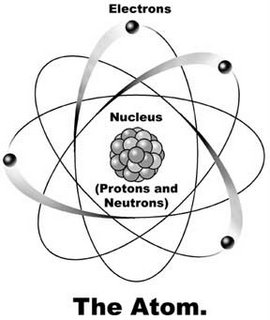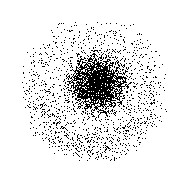Next Week:
- Here a Frequency, There a Frequency, Everywhere a Frequency;
- Fusing Science and Religion.
If I had studied physics in university, I might have enjoyed (much sooner) the coincidence of having a high school physics teacher named, Mr. Wheeler. I would have known that there was another physicist of the same name involved with a pretty strange branch of science called, quantum physics: the study of the universe on a subatomic level. John Wheeler proposed that the word “observer” be replaced with the word “participator” for he and other physicists had realized that this is a participatory universe. Even the mere act of observation has an impact on what is observed.
 Most of us learned that the atom consists of a positive nucleus (containing a positive proton and a neutral neutron), with one or more negative electrons orbiting around the nucleus like planets around the sun. The trouble with that is that those who study physics these days (even in high school) do not view the atom that way,
Most of us learned that the atom consists of a positive nucleus (containing a positive proton and a neutral neutron), with one or more negative electrons orbiting around the nucleus like planets around the sun. The trouble with that is that those who study physics these days (even in high school) do not view the atom that way,  so all the rest of us poor clods are working with a faulty mental model. In quantum physics, electrons are said to exist in orbitals or shells around the nucleus, somewhere in a cloud of probability. In effect, no one can say where the electron is precisely. That’s important to remember. (Beware though. That description is simplified and rather paraphrased.)
so all the rest of us poor clods are working with a faulty mental model. In quantum physics, electrons are said to exist in orbitals or shells around the nucleus, somewhere in a cloud of probability. In effect, no one can say where the electron is precisely. That’s important to remember. (Beware though. That description is simplified and rather paraphrased.)
Mental Models
Our view of the world is affected by everything we learn. However, if what we learn is incomplete or inadequate, we may forfeit valuable lessons that can broaden and add texture and detail to our perspective. Yesteryear’s high school view of the atom was adequate to explain the electron’s actions, charge and relative position, but it’s a bit like visiting an amusement park for the first time in your life – after it has been closed for the night. You might be able to describe it fairly well but what would be missing would be the descriptions of the way The Scrambler twists and turns as it revolves, or the sounds of the laughter and screams of thrilled riders. The atom too becomes far more interesting when we see it in action.
The Energetic Atom
The negative charge of the electron is always equal to the positive charge of the proton, so a great positive charge inside the nucleus equals a great and equal negative charge outside it, shared among the electrons. (The calcium atom, Ca, for instance, has 20 protons and 20 electrons.) When the atom is at rest, the two complementary charges exist in equilibrium, bringing the total charge of the atom close to zero. This is its ground state. When the electrons are in their lowest energy state, they are found at their lowest orbitals.
When interacting with the right amount of radiation (i.e. light), electrons become excited by the extra energy they have absorbed and jump to a shell or level farther away from the nucleus. Then, emitting the excess energy, they fall back to their original level. Electrons in orbitals close to the nucleus require less energy to become excited, and therefore radiate less energy than electrons farther away from the nucleus.
[Remember this mental model when you read a future post on anger.]
The amount of energy released by the electrons of a particular atom, create its own unique spectrum, by which the atom is known. Since the spectrum is described in terms of its range of frequencies, an atom of oxygen has a frequency pattern that is distinct from the frequency pattern of an atom of carbon, nitrogen, gold, silver, iron, and every other element.
When eleven carbon atoms get together in a particular formation with 12 hydrogen atoms, two nitrogen atoms and two oxygen atoms (C11H12N2O2), we call that chemical compound tryptophan. This molecule is required for serotonin production (C10H12N2O), which is instrumental to our mental well-being. We get tryptophan from turkey, chicken, fish, dried dates, milk, cottage and other cheeses, bananas, eggs, avocados, nuts, peanuts, and legumes.
1 comment:
Interesting stuff!
Why did you stop?
Post a Comment